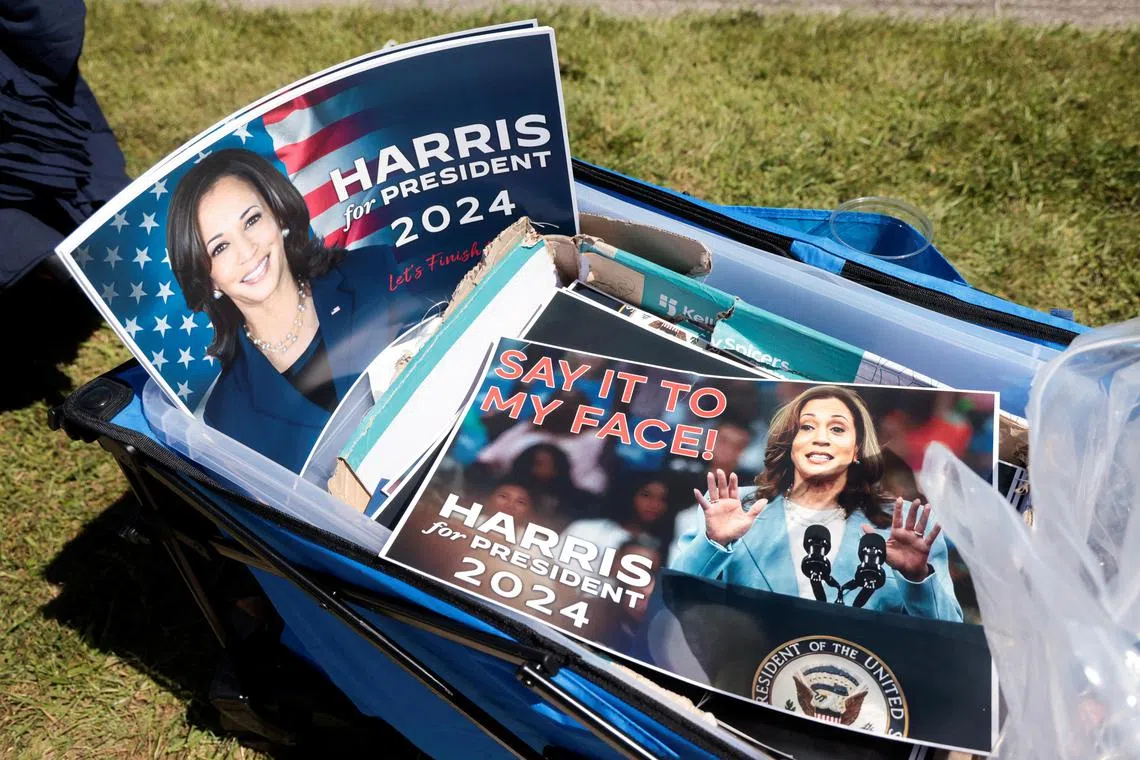US political ad spending soars – but does it work?
Sign up now: Get ST's newsletters delivered to your inbox

A Say It To My Face campaign poster of Ms Kamala Harris for sale outside a campaign stop in Detroit, Michigan.
PHOTO: REUTERS
Follow topic:
NEW YORK - US presidential election advertising budgets are off the charts in 2024, though it is not clear how well they work in swaying voters’ minds.
Around US$1.2 billion (S$1.55 billion) will be spent on ads for the presidential vote alone, according to ad analyst MediaRadar CMAG, out of a total of US$12 billion for congressional and other races being decided on Nov 5.
This latter figure is close to triple that of the 2016 election, but the upward trend goes back even further.
“The biggest change happened when Obama was running in 2008,” said Professor Mike Franz, co-director of the Wesleyan Media Project, which studies political ads.
Until then, candidates often used government funding for their campaigns under laws that placed strict limits on spending.
But Mr Barack Obama realised he could raise significantly more money through the newfound internet opportunities that were developing at the time, said Prof Franz.
“The internet has made it very easy to donate money to political candidates... just incredibly easy now”, compared with 20 or 30 years ago, said political science associate professor Zachary Peskowitz of Emory University.
Then in 2010, the Supreme Court lifted restrictions on spending by outside non-party groups.
This allowed for the creation of so-called “super PACs”, or political action committees, which can raise hundreds of millions of dollars for candidates, triggering even more political advertising.
But “political scientists are always curious about how much of this spending actually matters”, Prof Franz said.
“Because the campaigns are so tight in terms of the popular vote in some of these crucial battleground states, the money probably matters quite a bit,” he said. “But nobody really knows how much.”
“I think the safe bet is to just spend as much as you can,” said Prof Franz, adding that the result is “an arms race” between the two sides.
Old TV still matters
Even though Mr Obama revolutionised internet fund-raising, traditional television still lures considerable ad money – more than half the total.
That is true, even as more than half of Americans do not have even a cable television subscription any more, as streaming services gain ground.
“You’re trying to reach the most reliable voters. And reliable voters tend to be older. They tend to be elderly or middle-aged, and they’re watching broadcast or they’re watching cable,” said Mr Geoff Pereira of MediaRadar CMAG.
Google and Facebook owner Meta, which together take in just under half of all online advertising revenue, account for about only 9 per cent of campaign ad budgets for the 2024 election, according to Emarketer.
People might be suspicious of online ads, “and as a result, campaigns don’t want to necessarily sort of go all in on these new technologies”, said Prof Franz.
Research shows that ads promoting a candidate for office can in fact influence voters, even if just a bit.
“Common theories about what makes advertising persuasive have limited... power to predict persuasiveness,” according to a February article in the American Political Science Review.
After a certain threshold, “extra dollars do something small that could matter in a close election, but you’re reaching diminishing returns”, said political scientist David Broockman of the University of California, Berkeley.
But if one side simply stopped advertising, he added, “then we would likely see the side that was still advertising absolutely do far better, as their attacks aren’t being answered”.
The 2024 campaign’s dramatic ups and downs have contributed to an explosion of advertising, as Vice-President Kamala Harris belatedly replaced President Joe Biden as the Democratic torchbearer less than four months before Election Day.
Ms Harris needs “to spend a lot of money and advertise more to tell her story and make voters aware of her and her positions”, said Prof Peskowitz.
“And then the Trump campaign has the opportunity to use advertisements to help define her” in a negative way, he added.
Democrats outspent Trump on ads in 2016 and 2020, and are on track to do so again in 2024, according to MediaRadar CMAG. The Republican’s campaign is projected to dish out US$500 million, compared with US$700 million for the Democrats.
“His thinking is, I can put my money in other places” like trying to increase turnout, said Mr Pereira. That money is not counted the same way as ad spending.
“There are other ways of winning elections,” he said. AFP

